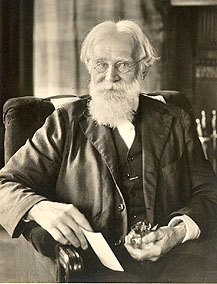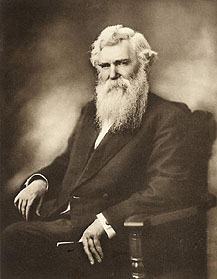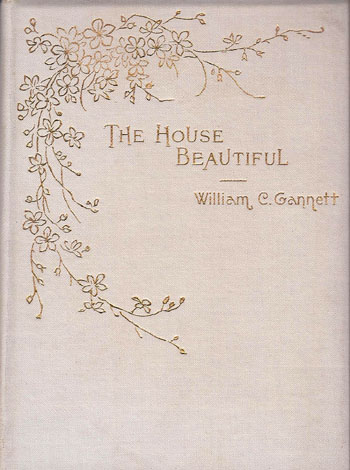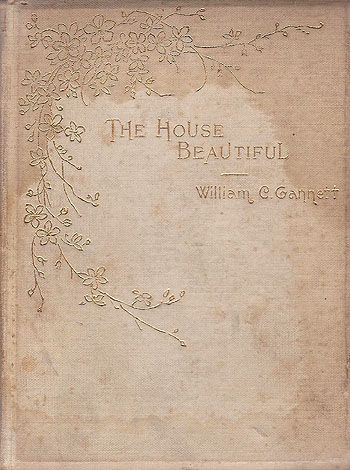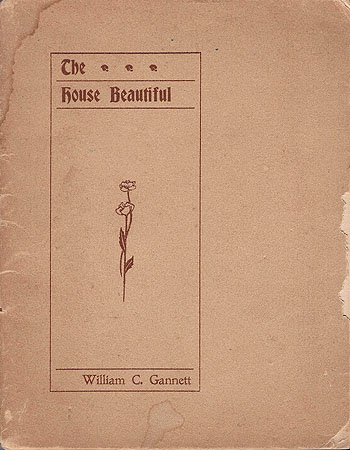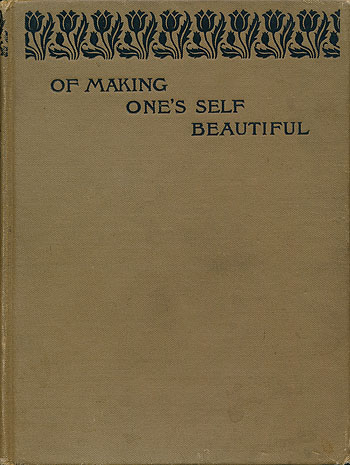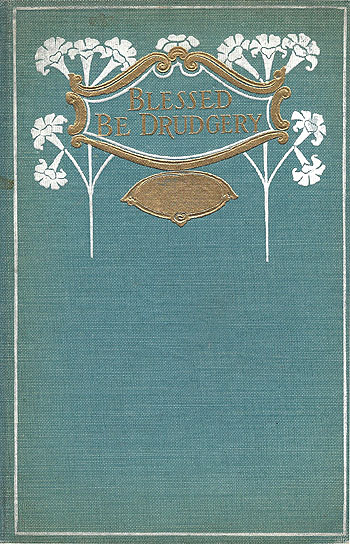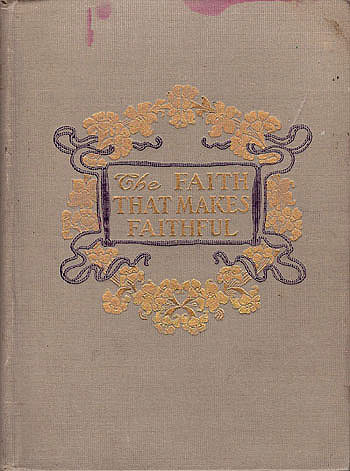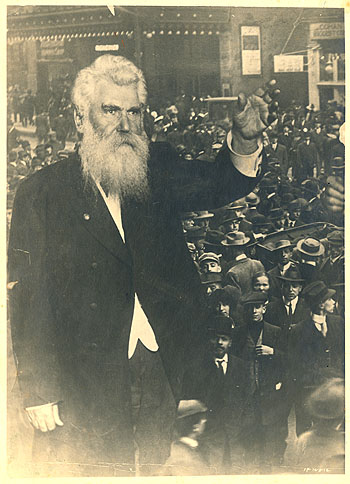
NOW AVAILABLE
CLICK TO ORDER
WILLIAM CHANNING GANNETT & JENKIN LLOYD JONES William Channing Gannett: In 1895 he published “The House Beautiful”. In 1896-7 it was published by The Auvergne Press which was established by two of Wright's clients, William H. Winslow and Chauncey L. Williams in the stable designed for Winslow. He was born on March 13, 1840 in Boston, Massachusetts. Gannett was educated at Harvard, where he received his Bachelor of Arts degree in 1860 and his Masters of Arts degree in 1863. During the 1860s, he also spent three years working with freed African Americans in Port Royal, South Carolina. From 1865 to 1866, he toured Europe. He then returned to Harvard. In 1868 he graduated from its Divinity School and became a Unitarian minister.
From his earliest years in the ministry, Gannett adopted the mantle of reform. While pastor of the Unitarian church in Milwaukee, Wisconsin (1868-1870), he actively participated in Milwaukee’s woman suffrage convention in 1869, and was vice president of the state’s woman’s suffrage association. In 1908, Gannett retired from active duty as pastor of Rochester’s Unitarian Church and assumed the title pastor emeritus. He died on December 15, 1923.
Jenkin Lloyd Jones: was born in 1843. The uncle of the architect, Frank Lloyd Wright, He became a Unitarian minister in Chicago. He became Missionary Secretary of the Western Unitarian Conference and editor of the liberal religious weekly, Unity. In 1889 Jones became a strong supporter of the Hull House Settlement that had been established by Jane Addams and Ellen Starr in the run-down Nineteenth Ward of Chicago. An opponent of child labour and supporter of the early trade union movement, gave lectures at Hull House to recently arrived immigrants from Europe. Jenkin Lloyd Jones died in 1918
He was the author of numerous works, among them is this volume. Although Jones was the most powerful western figure in the denomination, he encountered friction from the American Unitarian Association (AUA) because of his independent course and friction within the WUC because of his theological radicalism. In 1882 Jones reorganized the Fourth Unitarian Society in Chicago as All Souls Church, and a decade later he played a central role in the World's Parliament of Religions, which brought together a number of world religious leaders. The conference seemed a step toward Jones's dream of a universal church for humankind. He ended his career as director of the Abraham Lincoln Centre in Chicago, where he continued to be a voice of reform. In his last years, he spoke as a pacifist in opposition to World War I.Date: 1895 Title: The House Beautiful (Hard Cover) (Published by James H. West Co., Boston Mass.)
Author: Gannett, William Channing
Description: 1895 Cloth Version, Pre Frank Lloyd Wright. This was published two - three years before Frank Lloyd Wright published his version. It was a version like this he read. "I brought out a copy of William C. Gannet's (Sp) 'The House Beautiful,' an essay which I admired very much...".(3) There at least two cloth hard cover version published by James H. West Co. This version: white cloth, gold stamped cover. Inside front and back cover white-ivory paper. Original HC List Price Cloth, 50 cents; white and gold, full gilt, in box, 75 cents. (First Edition)
Size: 4.6 x 6.25.
Pages: Pp 60
S#: 0018.03.0301
Date: 1895 Title: The House Beautiful (Hard Cover) (Published by James H. West Co., Boston Mass.)
Author: Gannett, William Channing
Description: 1895 Cloth Version, Pre Frank Lloyd Wright. This was published two - three years before Frank Lloyd Wright published his version. It was a version like this he read. "I brought out a copy of William C. Gannet's (Sp) 'The House Beautiful,' an essay which I admired very much...".(3) There at least two cloth hard cover version published by James H. West Co. This version: white cloth, gold stamped cover. The only difference between this and the above version is that the inside front and back cover is a printed and gold stamped floral patterned paper. Original HC List Price Cloth, 50 cents; white and gold, full gilt, in box, 75 cents. (Note: water damaged cover) (First Edition)
Size: 4.6 x 6.25.
Pages: Pp 60
S#: 0018.04.1101
Date: 1895 Title: The House Beautiful (Soft Cover) (Published by James H. West Co., Boston Mass.)
Author: Gannett, William Channing
Description: 1895 Tinted Paper, Choice Edition. Pre Frank Lloyd Wright. This was published two-three years before Frank Lloyd Wright published his version. It was a version like this he read. "I brought out a copy of William C. Gannet's (Sp) 'The House Beautiful,' an essay which I admired very much...".(3) "Paper, choice edition, silk-stitched, white of tinted covers, put in entitled envelopes" (inside back cover). Original SC List Price choice edition 15 cents; cheap edition, 6 cents. (First Edition)
Size: 4.6 x 6.
Pages: Pp 26
S#: 0018.05.1101
Date: 1899
Title: Of Making One’s Self Beautiful (Hard Cover) (Published by James H. West Company, Boston)
Author: Gannett, William C.
Description: Preface: "This little book is an up-gathering. In some form or other the papers printed here have all been printed before, but much has been rewritten. There are probably echoes running from one to another of the five. Certainly there are many echoes from other minds in all of them. One or two seem to be almost compact of echoes. All thanks to the originators of whatever may be good. W. C. C." A compilation of five previously published papers and books: of Faces and Their Making; Culture Without College; The Thorn-Bearer; A Recipe for Good Cheer; and The House Beautiful. Printed on beige laid paper. Original list price 50c.
Size: 4.5 x 6.25
Pages: Pp 131
S#: 0036.12.0412Date: 1905
Title: Blessed be Drudgery (Hard Cover) (Published by James Pott & Co., New York)
Author: Gannett, William E.
Description: "Of every two men probably one man thinks be is a drudge, and every second woman at times is sure she is. Either we are not doing the thing we would like to do in life, or, in what we do and like, we find so much to dislike, that the rut tires, even when the road runs on the whole a pleasant way. I am going to speak of the Culture that comes through this very Drudgery..." This volume was published in 1905. Ten years earlier, Gannett published a little volume entitled "The House Beautiful," 1985. A year later FLW and his client William Winslow began collaborating on their volume of The House Beautiful. Original list price 35c. (First Edition)
Size: 5 x 7.5
Pages: Pp 32
S#: 0058.16.0816Date: 1907
Title: The Faith That Makes Faithful (This version published by James Pott & Company, New York. First published in 1896 by Charles H. Kerr & Company)
Author: Gannett, William Channing; Jones, Jenkin Lloyd
Description: A book of sermons by two Unitarian ministers. Eight chapters, four by each. Both having connections to Frank Lloyd Wright. (Second Edition)
Size: 4.5 x 6
Pages: Pp 228
S#: 0080.04.1206Date: Circa 1910
Title: Jenkin Lloyd Jones Circa 1910.
Description: Jones (November 14, 1843 - September 12, 1918) appears to be standing above the crowd, his left hand is raised as he addresses the crowd. The entrance to an unidentified auditorium is in the background. Hand written on verso: "Jenkin Lloyd Jones. (Quelling a mob at Auditorium, Chicago." Etched in the negative, bottom right hand corner: "1P-10-3-10." Jones was the uncle of architect Frank Lloyd Wright, He became a Unitarian minister in Chicago. He became Missionary Secretary of the Western Unitarian Conference and editor of the liberal religious weekly, Unity. In 1889 Jones became a strong supporter of the Hull House Settlement that had been established by Jane Addams and Ellen Starr in the run-down Nineteenth Ward of Chicago. An opponent of child labour and supporter of the early trade union movement, gave lectures at Hull House to recently arrived immigrants from Europe. He was the author of numerous works. Although Jones was the most powerful western figure in the denomination, he encountered friction from the American Unitarian Association (AUA) because of his independent course and friction within the WUC because of his theological radicalism. In 1882 Jones reorganized the Fourth Unitarian Society in Chicago as All Souls Church, and a decade later he played a central role in the World's Parliament of Religions, which brought together a number of world religious leaders. The conference seemed a step toward Jones's dream of a universal church for humankind. He ended his career as director of the Abraham Lincoln Centre in Chicago, where he continued to be a voice of reform. In his last years, he spoke as a pacifist in opposition to World War I.
Size: Original 9.25 x 12.75 B&W photograph.
S#: 0094.61.0819
